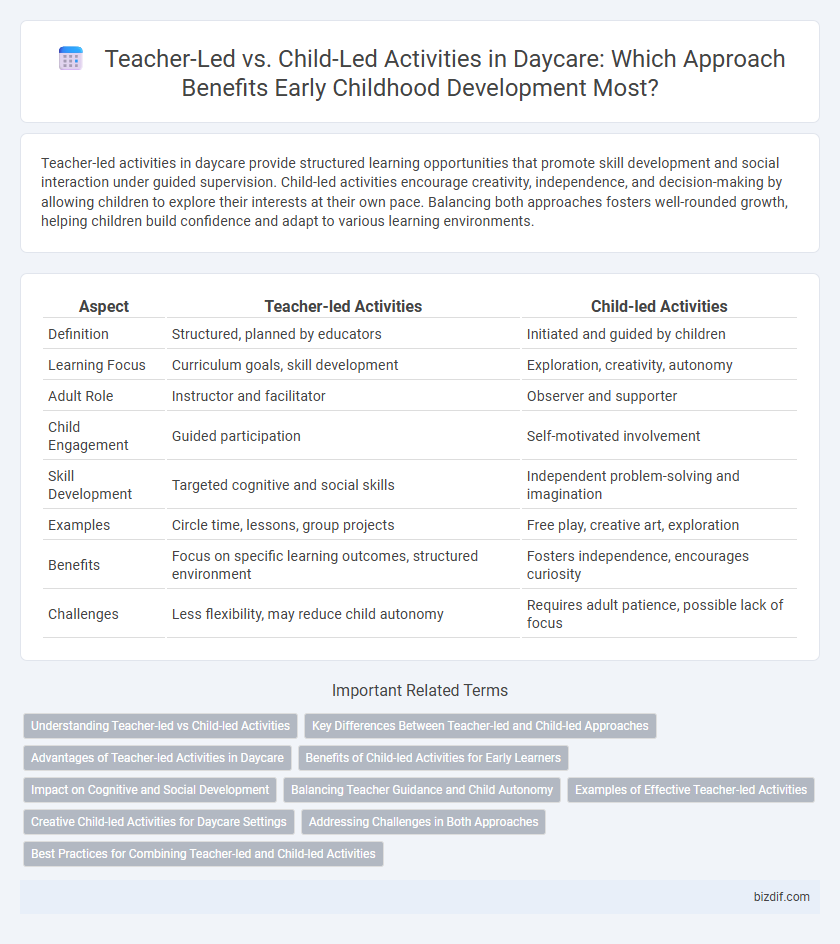Teacher-led activities in daycare provide structured learning opportunities that promote skill development and social interaction under guided supervision. Child-led activities encourage creativity, independence, and decision-making by allowing children to explore their interests at their own pace. Balancing both approaches fosters well-rounded growth, helping children build confidence and adapt to various learning environments.
Table of Comparison
| Aspect | Teacher-led Activities | Child-led Activities |
|---|---|---|
| Definition | Structured, planned by educators | Initiated and guided by children |
| Learning Focus | Curriculum goals, skill development | Exploration, creativity, autonomy |
| Adult Role | Instructor and facilitator | Observer and supporter |
| Child Engagement | Guided participation | Self-motivated involvement |
| Skill Development | Targeted cognitive and social skills | Independent problem-solving and imagination |
| Examples | Circle time, lessons, group projects | Free play, creative art, exploration |
| Benefits | Focus on specific learning outcomes, structured environment | Fosters independence, encourages curiosity |
| Challenges | Less flexibility, may reduce child autonomy | Requires adult patience, possible lack of focus |
Understanding Teacher-led vs Child-led Activities
Teacher-led activities in daycare involve structured guidance where educators direct learning through planned tasks to develop specific skills such as literacy and numeracy. Child-led activities empower children to explore and choose their own play, fostering creativity, independence, and decision-making. Balancing these approaches enhances cognitive, social, and emotional development by combining targeted instruction with self-initiated learning experiences.
Key Differences Between Teacher-led and Child-led Approaches
Teacher-led activities in daycare are structured and directed by educators, focusing on specific learning objectives and routine reinforcement, which ensures consistent skill development. Child-led activities prioritize children's interests and choices, encouraging autonomy, creativity, and intrinsic motivation through exploratory play. The key differences center on control and engagement methods: teacher-led approaches emphasize guidance and outcomes, while child-led strategies promote self-directed learning and adaptability.
Advantages of Teacher-led Activities in Daycare
Teacher-led activities in daycare offer structured learning experiences that promote cognitive development and social skills through guided instruction. These activities ensure consistent educational outcomes by following a curriculum designed to meet developmental milestones. Direct teacher involvement allows for immediate feedback and tailored support, enhancing children's understanding and engagement.
Benefits of Child-led Activities for Early Learners
Child-led activities in daycare foster creativity, independence, and problem-solving skills by allowing early learners to explore their interests at their own pace. These activities enhance cognitive development and social-emotional growth through experiential learning and peer interaction. Emphasizing child-led experiences supports intrinsic motivation and builds confidence critical for lifelong learning.
Impact on Cognitive and Social Development
Teacher-led activities in daycare settings scaffold cognitive skills such as problem-solving, language acquisition, and memory through structured guidance, promoting academic readiness and social norms understanding. Child-led activities foster autonomy, creativity, and critical thinking by allowing children to explore interests at their own pace, enhancing social development through peer interaction and conflict resolution. Balancing both approaches maximizes developmental outcomes by combining structure with freedom, supporting holistic growth in cognition and social skills.
Balancing Teacher Guidance and Child Autonomy
Balancing teacher guidance and child autonomy in daycare settings enhances developmental outcomes by integrating structured activities with opportunities for child-led exploration. Teacher-led activities provide essential skills and safety frameworks, while child-led activities foster creativity, independence, and decision-making abilities. A dynamic approach that adjusts the level of adult involvement to suit individual children's needs promotes optimal learning and engagement.
Examples of Effective Teacher-led Activities
Effective teacher-led activities in daycare settings include structured storytime sessions, guided sensory play, and educational group games, all designed to enhance language development and social skills. Teachers initiate interactive reading, use puppets for role-playing, and lead music and movement exercises that stimulate cognitive and motor skills. Such activities provide a balanced learning environment where educators support children's growth through intentional planning and active engagement.
Creative Child-led Activities for Daycare Settings
Creative child-led activities in daycare settings foster autonomy and enhance cognitive development by allowing children to explore their interests through imaginative play and problem-solving tasks. These activities encourage social collaboration and communication, promoting emotional intelligence and self-regulation skills. Research shows child-led approaches increase engagement and motivation, leading to stronger foundational learning outcomes.
Addressing Challenges in Both Approaches
Teacher-led activities provide structured learning experiences that ensure curriculum goals are met, but may limit children's creativity and autonomy, requiring teachers to balance guidance with flexibility. Child-led activities promote independence and engagement by allowing children to explore interests at their own pace, yet pose challenges in maintaining focus and achieving educational benchmarks. Effective daycare programs integrate both approaches by using adaptive strategies such as scaffolding and formative assessment to address individual needs and optimize development outcomes.
Best Practices for Combining Teacher-led and Child-led Activities
Effective daycare programs integrate teacher-led activities with child-led play to promote balanced cognitive and social development. Teachers should design structured lessons that encourage exploration and creativity while allowing children autonomy to pursue interests and regulate pace. Best practices include flexible scheduling, responsive observation, and promoting a supportive environment where guided learning and independent discovery coexist seamlessly.
Teacher-led Activities vs Child-led Activities Infographic

 bizdif.com
bizdif.com